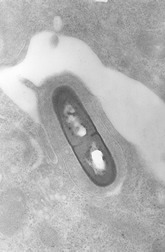This page has been archived and is being provided for reference purposes only. The page is no longer being updated, and therefore, links on the page may be invalid.
Read the magazine story to find out more. |
|
New Methods for Detecting Listeria
By Laura McGinnisOctober 12, 2006
Agricultural Research Service (ARS) scientists in Wyndmoor, Pa., are improving methods to detect foodborne pathogens like the potentially deadly Listeria monocytogenes.
Quick, accurate, cost-effective methods for detecting pathogenic bacteria—essential to ensuring a safe food supply—are part of ARS food safety research highlighted in the current issue of Agricultural Research magazine.
Listeriosis, the illness caused by L. monocytogenes infection, affects around 2,500 people in the United States every year, and kills about 500. Newborns, seniors, pregnant women and individuals with compromised or weakened immune systems are particularly susceptible.
Most methods for detecting harmful foodborne bacteria rely on antibodies, which are proteins used by the immune system to fight infections and foreign bodies. Because these antibodies target very specific infections, researchers can use them to identify and locate specific pathogens.
Antibodies vary in their degree of specificity. Current antibody-based methods for detecting L. monocytogenes can't distinguish this bacterium from the mixture of harmless bacteria found in most foods, according to Shu-I Tu. He's research leader of the Microbial Biophysics and Residue Chemistry Research Unit at the ARS Eastern Regional Research Center in Wyndmoor.
A molecular method called "phage display" uses bacteria and bacterial viruses, or phages, to quickly select antibodies to detect pathogens. Now ARS microbiologist George C. Paoli and chemist Jeffrey D. Brewster have employed phage display to isolate an antibody fragment that binds specifically to L. monocytogenes.
The researchers' success demonstrates that antibody phage display can be used to select antibodies for pathogen detection, even where traditional methods have proved inadequate.
Read more about the study and other ARS food safety research in the October 2006 issue of Agricultural Research magazine.
ARS is the U.S. Department of Agriculture's chief scientific research agency.

